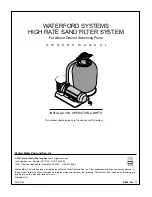
37
ixi gas pool and spa heater
Installation Manual
36
ixi gas pool and spa heater
Installation Manual
10.2 Saturation Index
Saturation Index = pH + AF + CF + TF -12.1*
A-Factor=(AF), C-Factor=(CF), T-Factor=(TF)
Total Alkalinity Calcium Hardness Temperature
A-Factor
C-Factor
T-Factor
PPM
Factor
Value
PPM
Factor
Value
°C
Factor
Value
5
=
0.7
5
=
0.9
0
=
0.0
25
=
1.4
25
=
1.0
3
=
0.1
50
=
1.7
50
=
1.3
8
=
0.2
75
=
1.9
75
=
1.5
12
=
0.3
100
=
2.0
100
=
1.6
16
=
0.4
150
=
2.2
150
=
1.8
19
=
0.5
200
=
2.3
200
=
1.9
24
=
0.6
300
=
2.5
300
=
2.1
29
=
0.7
400
=
2.6
400
=
2.2
34
=
0.8
800
=
2.9
800
=
2.5
41
=
0.9
A saturation index of 0 is perfectly balanced
A negative saturation index has corrosive tendencies
A positive saturation index has scaling tendencies
A saturation index of +0.3 or -0.3 is ideal
*-12.1 should be changed to -12.2 if Total Dissolved Solids (TDS)measure at
1,000 ppm or greater
Table 6.
Water Saturation Index
PH, Total Alkalinity (TA), temperature, Calcium
Hardness and Total Dissolved Solids (TDS) play a role
in whether the water is either corrosive or scale
forming. These factors are combined in the Langelier
Saturation Index, which is a method for determining
whether or not water is properly balanced. See
Table 6
.
The practice of putting tablet-based sanitizer in the
skimmer basket can produce heavily chlorinated water
with very low pH. If this comes in contact with metal
parts of the heater it can cause serious damage.
Practices like this should be discontinued.
If acidic conditions are present, there could be signs of
metal in the pool water that could cause staining on
the floor of your pool. This might manifest itself in the
form of brown stains on the finish of your pool bottom
or pool water discoloration. Your local pool dealer can
test for metals in your water or can provide you with a
test kit.
Every effort should be made to maintain the water
balance of your pool or spa in the proper range.
Ignoring this very important component of your pool’s
water chemistry can make the water less enjoyable to
bathe in and result in permanent damage to your
heater and/or complete failure of individual
components.
AstralPool does not warrant heat exchangers
damaged by corrosive water issues or from the build-
up of calcium in the heater’s heat exchanger. Any
questions regarding proper water balance can be
directed to our product support line at AstralPool® or
to your local pool dealer.
NOTE:
The Thermal Regulator Valve (TRV) is an indicator
of how well the water balance is being maintained.
The TRV should be inspected before each pool season
to ensure it is clean and operating properly. If you see
signs of calcium buildup (scale-forming or base water) or
corrosion (acidic water) the TRV should be replaced and
your water balanced. See Section 13.4 for image.
10.3 Swimming Pool Energy Saving Tips
Please review the following recommendations to help
conserve fuel and minimize the cost of operating your
pool heater without sacrificing comfort.
• The recommended maximum water temperature
is 26 °C (79 °F). Use an accurate pool thermometer.
A difference of 2 °C (3 °F), between 26 °C (79 °F)
and 28 °C (82 °F), will use as much as 40% more
gas.
• Carefully monitor the water temperature of your
pool in the summertime. You can reduce heater
usage due to warmer air temperatures.
• Find the proper setting on the pool heater
temperature control and use the Set Point Lockout
feature to discourage further adjustments.
• Set the pump time clock to start the pump no
earlier than 6:00 AM. This is the time when nightly
heat loss balances.
Recommended Levels
Fiberglass Pools
Fiberglass Spas
Other Pool and Spa Types
Water Temperature
20-31
°
C (66-88
°F)
31-40 °C (89-104 °F)
20-40 °C (68-104 °F)
pH
7.3 - 7.4
7.3 - 7.4
7.6 - 7.8
Total Alkalinity (ppm)
120 - 150
120 - 150
80 - 120
Calcium Hardness (ppm)
200 - 300
150 - 200
200 - 400
Salt (ppm)
4500 Maximum
4500 Maximum
4500 Maximum
Free Chlorine (ppm)*
2 - 3
2 - 3
2 - 3
Total Dissolved Solids (ppm)
3000 Maximum**
3000 Maximum**
3000 Maximum**
*Free Chlorine
MUST NOT EXCEED
5 ppm!
.
**In saltwater
chlorinated pools, the total TDS can be as high as 6000 ppm.
Table 5.
Pool Water Chemistry













































